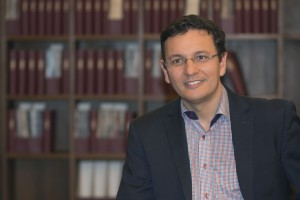Award for Paper on Simulation of Flow Processes
SIAM Society honours research publication in the field of applied mathematics
With one of the highest possible awards in the field of applied mathematics the Society for Industrial and Applied Mathematics (SIAM) has honoured the authors of a paper on computer-supported simulation of flow processes that appeared last year in one of the society’s five journals. Among the SIAM publications the Heidelberg paper was chosen as the one with outstanding research results of special overall significance. The basic work was conducted at the Interdisciplinary Center for Scientific Computing (IWR) of Heidelberg University and the Heidelberg Institute for Theoretical Studies (HITS) in cooperation with French researchers. SIAM recognises only one publication each year as part of the SIGEST programme.
The computer-supported simulation of so-called periodic flow processes is central to understanding the transition from laminar to turbulent or chaotic flows. In this process, a uniform, well-organised movement of fluids or gases transforms into a flow with visible turbulence. The swirling in the transition phase can be seen by the naked eye, such as that observed at river bridge pylons. According to Prof. Dr. Vincent Heuveline, periodic flow patterns are generally very complex. Modelling them requires many parameters that can only be identified with a certain level of uncertainty, due to imprecise measurements, for example. “In applied mathematics, calculating them is known as the ‘grand challenge’,” explains Prof. Heuveline, the research group leader at the IWR who also heads an associated group at HITS. “For a long time it just wasn’t clear whether the dynamics of such solutions could be modelled mathematically at all.”
Now the researchers have succeeded in solving the problem by applying approaches from optimisation, computational science and stochastics. They combined the search for optimal parameters for a complex system and the development of new algorithms for continual mathematical problems with stochastic methods that unite probability theory and statistics. The German-French research team thus developed a new computer-assisted process that Prof. Heuveline explains can calculate periodic flow processes “with extreme accuracy”. The fundamental idea is based on characterising flow as a combination of a stochastic period and a stochastic initial state. An optimisation step ensures that the initial and end state after a period are as close together as possible. This process is repeated until acceptable precision is reached. “The uncertainties are modelled into the related equations as a new dimension, which is of critical significance,” says the study’s primary author, Dr. Michael Schick. However, this causes the number of variables to be solved to explode, he continues. To keep this number as low as possible, a so-called stochastic time is defined in addition to the optimisation step. “That way we can capture the uncertainty-driven fluctuations in the periodic solution. Only then are extremely precise simulations possible,” emphasises Dr. Schick, a member of Prof. Heuveline’s team.
The research results were published in 2014 in the “SIAM/ASA Journal on Uncertainty Quantification”. As a result of the award, the paper will be published again in early 2016 and appear in the SIGEST category in the journal “SIAM Review”. It will also be presented at the SIAM annual conference. In addition to Dr. Schick and Prof. Heuveline, Prof. Dr. Olivier Le Maître of the Computer Science Laboratory for Mechanics and Engineering Sciences (LIMSI) in Paris also contributed to the publication.
Original publication:
M. Schick, V. Heuveline and O.P. Le Maître: A Newton-Galerkin Method for Fluid Flow Exhibiting Uncertain Periodic Dynamics. SIAM/ASA Journal on Uncertainty Quantification (2014), Vol. 2, No. 1, pp. 153-173, doi: 10.1137/130908919
Press Contact:
Dr. Peter Saueressig
Head of Communications
Heidelberg Institute for Theoretical Studies (HITS)
Phone: +49-6221-533245
peter.saueressig@h-its.org
Twitter: @HITStudies
About HITS
HITS, the Heidelberg Institute for Theoretical Studies, was established in 2010 by physicist and SAP co-founder Klaus Tschira (1940-2015) and the Klaus Tschira Foundation as a private, non-profit research institute. HITS conducts basic research in the natural, mathematical, and computer sciences. Major research directions include complex simulations across scales, making sense of data, and enabling science via computational research. Application areas range from molecular biology to astrophysics. An essential characteristic of the Institute is interdisciplinarity, implemented in numerous cross-group and cross-disciplinary projects. The base funding of HITS is provided by the Klaus Tschira Foundation.

